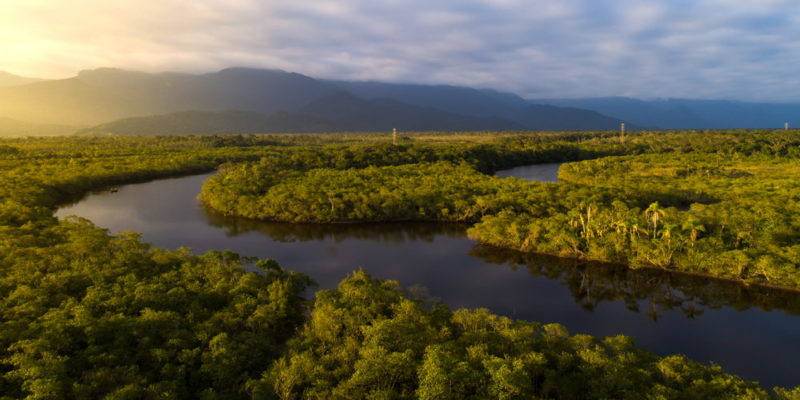We explain everything about Latin America, the countries that make it up and what its characteristics are. Also, their cultures, biodiversity and more.
What is Latin America?
Latin America or Latin America is a geographical and cultural region of the American continent , the second largest continent in the world, made up of countries whose official language is a language derived from Latin (Spanish, Portuguese or French). Its territory has an area of 19,200,000 km² and ranges from Mexico to Argentina. It borders the Pacific Ocean to the west and the Atlantic Ocean to the east.
It is made up of twenty countries and the total population is around 650 million inhabitants . Most of the Latin American countries are Spanish and Portuguese speaking. Only 3% of Latin Americans speak French. The gentilicio “Latino” is often used to refer to people of Hispanic origin.
Latin America stands out for its great biodiversity due to its vast territory in which a significant number of plant and animal species coexist . In addition, there are numerous and valuable natural resources , such as freshwater reserves and ecosystems of global climatic importance, such as the Amazon.
Characteristics of Latin America

Among the main characteristics of Latin America, it stands out that:
- It is made up of 20 countries in which, for the most part, the Spanish language is spoken. Portuguese and French are spoken to a lesser extent.
- It presents a great diversity of races, such as indigenous natives , mestizos (children of indigenous people and Europeans), mulattos (children of mestizos and Africans), among others.
- It has a fifth of the world’s forests .
- It has a third of the world’s fresh water reserves .
- It has significant mineral reserves such as lithium, silver , copper, and tin.
- It represents 12% of the arable surface of the planet.
- The largest age group, 237 million people, is made up of young people under 25 years of age.
Culture of latin america
Despite the cultural diversity that differentiates one country from the other, the American continent is divided into two main regions according to the language that predominates in each place:
- Anglo-Saxon America . It includes Canada, the United States, and the Caribbean islands such as the Bahamas, Bermuda, Belize, Antigua and Barbuda, Jamaica, Grenada, and Saint Lucia, among others. In these countries the English language predominates because most are former English colonies.
- Latin America . It ranges from Mexico to Argentina and they are countries in which the Spanish and Portuguese language predominate and which were, for the most part, Spanish and Portuguese colonies.
Latin America stands out for its cultural diversity, the result of the influence of the colonizing countries , of the inhabitants from other latitudes, such as Africa , and of the native peoples of America (cultures that were diminishing their influence after the colonization of European countries).
Biological diversity in Latin America

Latin America has the greatest biodiversity on the planet , with a wide variety of plant and animal species due, among other issues, to the presence of diverse climates throughout its vast territory.
Trees abound , such as avocados, palm trees, cherry trees, pineapples, larches, araucarias, pines ; and plants , such as ferns, banana trees , roses, and orchids.
In addition, a wide variety of animals abound such as tapirs, armadillos, eagles , frogs, flamingos, jaguars, monkeys , anteaters, pumas, toucans , whales , penguins, jaguars, condors, crocodiles and snakes .
It has some of the most important rivers in the world, such as the Papaloapan River in Mexico, the Loa River in Panama, the Amazon River in Brazil, and the Rio de la Plata in Argentina.
Latin America Climate
The climate of Latin America is very varied due to the size and characteristics of the territory . In the countries closest to the Caribbean region, temperatures are very hot, although there are areas where it usually snows, such as Sierra de Sinaloa in northwestern Mexico.
A little further from the equator towards the south of Latin America the climate is warm of a tropical type . In the southern region the temperate climate predominates, which can be oceanic near the coasts or temperate-continental deep into the continent.
The power and beauty of Latin American river systems is one of the conditions that have made this region famous worldwide. Rivers such as the Loa, Panama, the Amazon or La Plata stand out for their extension and for the richness of natural resources and ecosystems.
Latin America population density

Latin America is considered one of the regions with the greatest urban deployment , since 82% of the Latin American population lives in cities , such as Mexico City , São Paulo, Buenos Aires or Rio de Janeiro, which have the highest population density.
Latin American countries
The twenty countries that make up Latin America are:
- Argentina . It is a Spanish-speaking country, because it was a Spanish colony until 1816, located in the extreme south of South America and its capital is the city of Buenos Aires. Argentina is a country divided into 23 provinces and inhabited by more than 44 million people.
- Bolivia . It is a country located in the center of South America that has a population of more than 11 million inhabitants who speak the Spanish language and other indigenous languages, such as Quechua and Aymara. It has the capital in the city of Sucre, although the city of La Paz is the seat of the government .
- Brazil . It is a country located in the east of South America and is the largest on this continent with 8.5 million km². Its capital is in the city of Brasilia and most of its inhabitants speak the Portuguese language, because Brazil was a Portuguese colony until 1824. It is characterized by its great biodiversity and for hosting the Amazon, one of the longest and mightiest rivers in the world.
- Chile . It is a Spanish-speaking country (it was a Spanish colony until 1818) located in western South America and is divided into 16 regions. It is inhabited by more than 18 million people and its capital is Santiago de Chile. Chile is characterized by its extensive coastline and by the Andes mountain range that crosses its territory from north to south and serves as a natural border with Argentina.
- Colombia . It is a Spanish-speaking country located in the north of South America with access to the Pacific Ocean and the Caribbean Sea. The capital of Colombia is the city of Bogotá and it is a country with more than 50 million inhabitants living in the 32 departments into which its territory is divided. Colombia obtained its independence from Spain in 1819.
- Costa Rica . It is a Spanish-speaking country (it was a Spanish colony until 1821) located in Central America and has an outlet to the Pacific Ocean and the Caribbean Sea. It is divided into 7 provinces in which more than 5 million people live and its capital is located in the city of San José, Costa Rica.
- Cuba . It is an island located in the Caribbean Sea and its territory is divided into 15 provinces where more than 11 million people live. The capital of Cuba is the city of Havana and the official language of this country is Spanish (it obtained its independence from Spain in 1898).
- Ecuador . It is a country located in the northwest of South America. Its capital is the city of Quito and the rest of the territory is divided into 24 provinces. Ecuador has a population of 17 million inhabitants and most of them speak the Spanish language (Ecuador was a Spanish colony until 1820).
- El Salvador . It is a country located in Central America and with a coastline on the Pacific Ocean. It is divided into 14 departments and its capital is the city of San Salvador. It is inhabited by more than 6 million inhabitants, most of whom speak the Spanish language (El Salvador was a Spanish colony until 1821).
- Guatemala . It is a country located in the extreme north of Central America. It is made up of 22 departments in which more than 16 million people live and the capital is located in Guatemala City. It was a Spanish colony until 1821, the year in which it became independent, and its official language is Spanish.
- Haiti . It is a country located in the Caribbean Sea and its capital is the city of Port-au-Prince. Its population, of more than 11 million inhabitants, is distributed among the 10 departments that make up its territory. The official languages of this country are French (since Haiti was a French colony until 1804, the year of its independence) and Haitian Creole.
- Honduras . It is a country located in Central America and that is divided into 18 departments in which more than 9 million people live. The capital of Honduras is Tegucigalpa and its official language is Spanish, because this country was a Spanish colony until 1821.
- Mexico . It is a country located in the extreme south of North America and has its capital in Mexico City. It is one of the largest countries in Latin America and its territory is home to more than 127 million people. Its official language is Spanish, because it was a Spanish colony until 1821.
- Nicaragua . It is a country located in Central America with capital in the city of Managua. Nicaragua is divided into 15 departments and is inhabited by more than 6 million people. Its official language is Spanish since it became independent from Spain in 1821.
- Panama . It is a country located in the extreme south of Central America and has access to the Pacific Ocean and the Caribbean Sea. It is divided into 10 provinces and its capital is the city of Panama. It was a Spanish colony until 1821, so its official language is Spanish. In its territory is the Panama Canal , a work built to unite the Pacific Ocean with the Atlantic.
- Paraguay . It is a country located in the center of South America with capital in the city of Asunción. Its territory is divided into 17 departments and has a population of approximately 7 million inhabitants. Its two official languages are Guaraní and Spanish (the country of which it was a colony until 1842).
- Peru . It is a country located in the west of South America that is inhabited by 32 million people. Its territory is divided into 24 departments and its capital is the city of Lima. Its official language is Spanish (it became independent from this country in 1821), but languages such as Quechua and Aymara are also important.
- Dominican Republic . It is a country located in the Caribbean Sea within the island of Hispaniola. It has a population of 10 million inhabitants and its capital is in the city of Santo Domingo. Its official language is Spanish, since it was a Spanish colony until 1844.
- Uruguay . It is a country located in the southeast of South America and with capital in the city of Montevideo. Uruguay is inhabited by 3 million people who live in the 19 departments into which the country is divided. Its official language is Spanish and it was a Spanish colony until 1825, the year of its independence.
- Venezuela . It is a country located in the north of South America and with capital in the city of Caracas. Its territory is divided into 23 states, inhabited by almost 30 million people. The official language of Venezuela is Spanish and it was a Spanish colony until 1811.
The above content published at Collaborative Research Group is for informational and educational purposes only and has been developed by referring reliable sources and recommendations from technology experts. We do not have any contact with official entities nor do we intend to replace the information that they emit.














